Child’s play?
 Not exactly. This episode’s challenge: to create an artwork that compliments and relates to a child’s work of art, as each participant arrives in the studio to find an elementary school student at his or her desk.
Not exactly. This episode’s challenge: to create an artwork that compliments and relates to a child’s work of art, as each participant arrives in the studio to find an elementary school student at his or her desk.
Growth opportunity? Collaborative sparks?
Some of the artists seem to think so, yet the results are generally uninspiring, with a few exceptions. Then there’s the unexpected display of emotions from both Sara J and the Sucklord – the former’s dip into a traumatic past, and the latter’s distracting desire to please the child rather than himself – or the judges.
Last season’s foray into child-like imagination required the artists to use a restrictive set of materials; I seem to recall disliking much of the mediocre madness that manifested. I prefer this season’s approach, though the artwork produced is equally hit-or-miss.
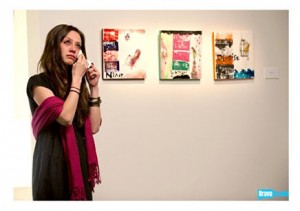 10-year old Zelda offers one of my favorite pieces of the night – a colorful and large-scale word painting, exuding exuberance and balanced composition, and far more impressive than much of what the adults accomplish.
10-year old Zelda offers one of my favorite pieces of the night – a colorful and large-scale word painting, exuding exuberance and balanced composition, and far more impressive than much of what the adults accomplish.
Sadly, Sara J is paired with this piece, and thrown back to her own experience as a 10-year old – her mother’s affair, a half-brother, and the divorce that followed. The judges deem her trio of word-paintings less than satisfactory, and while they share Zelda’s color palette, they have no correspondence to the little girl’s work or spirit, and everything to do with Sara’s painful past. This artist winds up on the bottom, and barely escapes elimination.
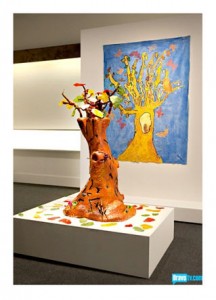 The Sucklord, it turns out, is a bit of a softie. He’s so enthralled by Reynie and her gleeful tree that he loses his focus, producing an amateurish sculpture with action figures tucked into its nooks and crannies.
The Sucklord, it turns out, is a bit of a softie. He’s so enthralled by Reynie and her gleeful tree that he loses his focus, producing an amateurish sculpture with action figures tucked into its nooks and crannies.
So irritated is judge Jerry Saltz at the Sucklord’s continued one-note performance, he threatens to “go medieval” on him, if he doesn’t start using some genuine imagination.
Shades of Kara Walker (minus the provocative social statements), Marlo’s silhouetted collage of cats gone fishing is playful and engaging to the eye. Sarah K creates a companion piece comprised of a shadow box something I can’t quite make out, but it earns a passing grade.
Young is tasked with interpreting a brightly colored bird-mobile, so he takes flight and photographs himself leaping – entertaining to observe – then whimsically decorates his image with feathers. Entitled “Prism in Flight,” it’s not a bad idea, though his excess of plumage obscures too much of the figure.
And then there’s Michelle, and I’m left scratching my head (bloody?) again. How does she manage to interpret a child’s painting of squinting eyes as an opportunity to sculpt warring geese tangled in a violent peck-off?
Fortunately for her, Simon persuades her to tone it down. She retools her sculpture into a gaggle of greenery with hidden creatures. But if Simon hadn’t steered her clear, would she have been expelled?
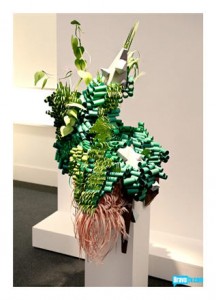 Surely a candidate for the Stay After School crowd, Lola’s false start to nowhere was also headed off by Simon. But her finished effort matches a flower drawing with a painted, scribbled, photographic mess. Couldn’t Josie’s blue background with a blossom and butterflies have yielded a Lola rose that would smell as sweet?
Surely a candidate for the Stay After School crowd, Lola’s false start to nowhere was also headed off by Simon. But her finished effort matches a flower drawing with a painted, scribbled, photographic mess. Couldn’t Josie’s blue background with a blossom and butterflies have yielded a Lola rose that would smell as sweet?
As for Tewz on the bottom, his somber garden holds no corresponding color (or joy) with its paired painting of vegetation by Kyle.
Still, its cracked concrete with green shoots suggests more imagination than Lola’s flowers, more presence than the Sucklord’s tricked-up tree, and the concept – if not wildly original – nonetheless shows some merit.
Visually? I agree with the judges. It’s hardly an ideal accompaniment to the child’s work, but the juxtaposition of the two together isn’t uninteresting.
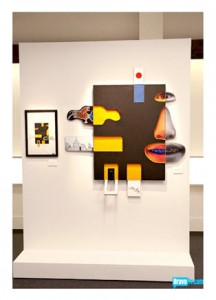 So who makes winning wunderkind along with the second place photo finish?
So who makes winning wunderkind along with the second place photo finish?
Art teacher Dusty is inspired by Kei’s abstraction in (what appears on screen as) black and red and yellow. With a little conversation and the aid of his camera, he cleverly reinterprets the suggestion of doors and windows in a large 3-D version that channels the slightest hint of Hannah Hoch, in an innocent and interactive Dada collage. It’s a charming portrayal.
The judges – including guest Sarah Jessica Parker – think it’s pretty cool, and resembles an Advent calendar.
Looking at Kei’s artwork as well as Dusty’s (when the hinges on the movable parts are closed), I flash to the curvaceous and musical abstractions of painter Caio Fonseca, but hey – to each his own – Dusty’s “Portrait of Kei” is an undisputed thumbs up.
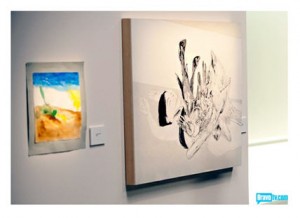 Taking home the prize is Kymia, who struggled with a simple blue, white, and orange depiction of a carrot on a beach.
Taking home the prize is Kymia, who struggled with a simple blue, white, and orange depiction of a carrot on a beach.
Unlike Lola who was stymied by an image and pursued no further, Kymia persisted in chatting with child artist Alana, until a story unfolds.
Apparently, before the lone carrot, there is a girl by the sea who gobbles up everything in sight, places the carrot between her lips and then in grim(m?) fairy tale fashion – perishes. From Alana’s story comes an illustration that is connected (via words more than imagery) to the original artwork, and the quality of the drawing catches the judges’ fancy.
Personally, I would’ve booted Lola and handed the win to Dusty, but I yield to the fact that sitting in front of our screens we can’t fully see what the judges must.
Images courtesy BravoTV.com. Click images to access full size sources.
Hmmm… I rather like the green bushy thing with the upside down “hair” and also the brown/yellow/orange one (nice color contrasts and going outside the frame). Forget any further analysis of “inner child” or the like. Carrot in sand leaves me cold, like a one-trick pony.